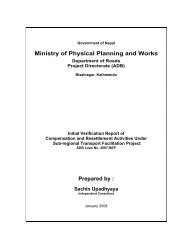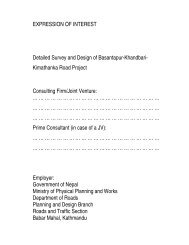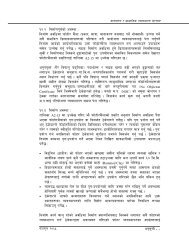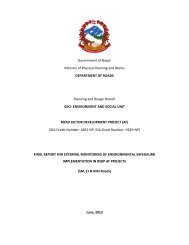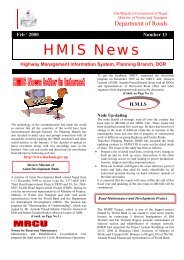Environmental & Social Management Framework - About ...
Environmental & Social Management Framework - About ...
Environmental & Social Management Framework - About ...
Create successful ePaper yourself
Turn your PDF publications into a flip-book with our unique Google optimized e-Paper software.
<strong>Environmental</strong> and <strong>Social</strong> <strong>Management</strong> <strong>Framework</strong>Frequently, ploughing the RoW for cultivation to the very edge of the roadshoulder makes the adjacent land susceptible to erosion and landslides.Similarly, water leaking from the irrigation canals located near the road or fromthe irrigated land, quarrying of soil (for mud plastering of houses) and stone fromroad slopes, destruction of vegetation due to animal grazing, impacts from hoofedanimals on embankment slopes, fodder collection (mowing), slash and burncultivation in road corridors and road reserves, etc. may also result in locallandslides and soil erosion.Examples for hazardous spoil disposal and the controversies associated withdepositing spoil in rivers are illustrated in the following Box 2.Spoil Disposal in Rivers: A fact in contradictionBox 2Disposal of spoil in water courses and rivers is considered internationally as a practice which isdamaging to the environment. This has arisen as a result of greater environmental awareness incountries with smaller rivers and less variation between normal and peak river discharges. In Nepal,the reverse is probably is the case. The mountains of Nepal are so unstable, and the natural ratesof degradation so high, that it is unlikely that man can add significantly to this. The large rivers carryenormous sediment loads: (Brunsden et al.,1981) quote the following rates per unit area of the rivercatchments:Rivers of Nepal Sediment yield (m 3 /km 2 /yr. Basin denudation rate (mm/yr.)Arun (1947) 1,830 1.8Arun (1947 – 1960) 1,889 1.9Sun Koshi 2,480 2.5Tamur (1948 – 50) 4,730 4.7Smaller rivers often have steep bed gradients and in floods show significant aggradation orsedimentation, depending on the nature of the storm and the landslide activity in the uppercatchment. For example, in a flood in 1997, the bed of the Leoti Khola beside the Dharan-Dhankutaroad rose by an average of about 5 m. Seasonal rivers in Churia and Mahabharat ranges oftenhave bed gradients of about 15 0 and in floods can take on the characteristics of a debris flow ratherthan a river.Against this background, the disposal of debris into rivers, if possible, seems a better course ofaction than trying to retain it on slopes which are already at a marginal factor of safety. Problemsoccurred with spoil disposal along Naubise-Mugling and Mugling-Marsyangdi road sectionsbecause spoil was left hanging on the steep slopes rather than being pushed right down into river.Between 1992 - 1995, millions of cubic meters of limestone and shale debris were removed eachyear by the Trishuli from the Jogimara landslide site alone, with no appreciable downstream effects.It therefore seems clear that disposal of almost any quantity of spoil into river, seasonal orperennial, with a bed gradient of less than 20 0 , is an acceptable solution. Gullies with steeper bedgradients may become re-activated as a result of scour generated by disposed spoil, and so thislimit should not be exceeded.Source: Briefing Paper on <strong>Environmental</strong> Issues and <strong>Environmental</strong> Assessment in Road Sector, RAP, 1999e. Water Flow DiversionRoads that intersect drainage basins generally modify the natural flow of surfacewater by concentrating flows at certain points and, in many cases, increase thespeed of flow. Diversion or disruption of natural surface water flow and drainageis often inevitable in road projects.Blockage of natural drainage path during construction or maintenance – forexample by environmentally hazardous disposal of spoil material - may generatewater depletion, water logging, a concentration of water flow as well as increasethe speed of flow, which will be erosive in nature. Diversion as well asoverloading existing drains results in water flowing where it normally would not,Chapter 4-10 April 2007



![j:6 ]zg cfof ]hgf](https://img.yumpu.com/51286794/1/190x245/j6-zg-cfof-hgf.jpg?quality=85)

![x'nfsL /fhdfu { cfof ]hgf](https://img.yumpu.com/50581959/1/190x245/xnfsl-fhdfu-cfof-hgf.jpg?quality=85)
